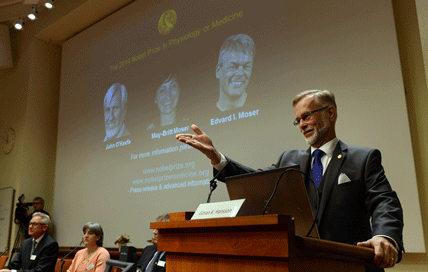Secretary of the Nobel Committee for Physiology or Medicine announcing the 2014 Nobel joint prize to John O’Keefe, Edvard Moser, and May-Britt Moser in Stockholm, Sweden, October 6, 2014
Where am I? you may ask yourself. How do you know your position within and move through the spatial world? Scientists whose study of these basic questions resulted in the discovery of the brain’s “inner GPS” have been awarded this year’s Nobel Prize in Medicine or Physiology. Sharing the $1.1 million prize money are UK-based researcher Professor John O’Keefe and the husband-wife team of May-Britt Moser and Edvard Moser from Norway. Together their research contributed to new understandings of how specialized brain cells work together to create complicated thinking abilities like memory and planning.
We’re all increasingly familiar with GPS (global positioning system) technology, which relies on satellites orbiting the world relaying data 24/7. New cars come equipped with GPS systems; GPS is built into smartphones; parents even buy backpacks for their kids with embedded GPS chips. But how do we as human beings figure out our location and know how to move from point A to point B, without technology? The answer, not surprisingly, is the same way that rats do!
The research of this year’s Nobel Prize winners began with lab rats. They found that certain nerve cells in the rodents’ brains were activated as the rats scurried around. O’Keefe discovered the “place cells,” in the hippocampus, which apparently aid rats in recognizing different locations. Almost 35 years later, the Mosers identified similar “grid cells” that help rats make mental maps of their position. Combined, the place cells and grid cells are the neural mechanism that underlies spatial memory. Later findings confirmed that human brains also operate in this way. The circuitry between these groups of specialized brain cells gives us the ability to recognize our location in space, navigate through space, and remember our spatial positioning.
An important medical application of this research may come in the treatment of Alzheimer’s disease. For persons suffering from Alzheimer’s and dementia, the ability to find their way around is one of the first things that goes.
Image credit: © JONATHAN NACKSTRAND/AFP/Getty Images
Related Links
- “Inner GPS” Discovery Wins Nobel Prize in Medicine
Listen to a discussion on the awarding of the 2014 Nobel Prize in Physiology or Medicine to the discoverers of the human brain’s “inner GPS.”
(Source: NPR, October 6, 2014) - Nobel Prize for the Brain’s GPS Discovery
This article discusses the brain research that was recognized in this year’s Nobel Prize in Physiology or Medicine.
(Source: BBC News, October 6, 2014) - Press Release: The Nobel Prize in Physiology or Medicine 2014
This is the official press release announcing the Nobel Prize in Physiology or Medicine; includes short bios of the three scientists who share the award, and a brief list of their key publications.
(Source: NobelPrize.org, October 6, 2014)





I like this article.
cool
Really interesting article.